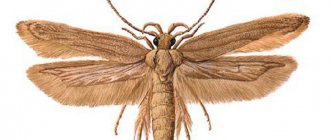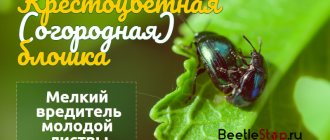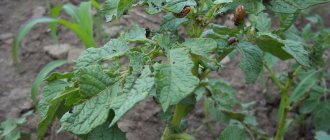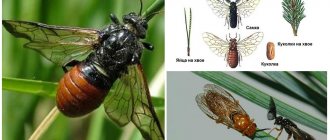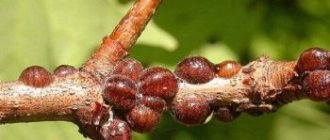Control
The pest was previously controlled by seed treatments before the controversial chemicals were banned by the EU due to concerns about their effects on bees.
Agronomic practices that promote good plantings and rapid seedling growth will reduce the impact of flea beetles on grain and cereal yields. Germination and growth can be improved by sowing seed lots with higher seed weights and germination rates above 95%.
Seed size: Seedlings grown from large seeds (1.8-2.2 mm) are more vigorous and resistant to flea damage than seedlings grown from small seeds (1.4-1.8 mm). Cereals grown from large seeds suffer less damage from stem flea beetle, seedlings are more developed, have a high mass of shoots and a higher seed yield than plants grown from small seeds.
Soil treatment: Fleas prefer sunny, relatively warm conditions. Winter sowing provides a microclimate that is less suitable for stem flea beetles than tillage before sowing. The effects of injury can be reduced by the cooler microenvironment created by shading the stubble on the soil surface. Cooler temperatures at the soil surface slow down flea activity, therefore reducing damage. However, crop development may also be slowed by lower temperatures, so regular monitoring of seedlings is still necessary to ensure damage thresholds are not exceeded.
Planting Date: Growers are urged to plant cereals and grains as early as possible to maximize seed yield. Planting early will increase the size of the plant before fleas appear, and larger plants cope better with flea damage.
Seeding Rate: Increasing seeding rates can help reduce the impact of stem flea beetle damage because spreading feeding damage to more plants per area means insect damage is reduced and seedlings recover more quickly from injury.
Insecticides for seed treatment. Mixing a portion of insecticide-free seed with treated seed for planting is a practice that is of interest to some growers and researchers for reducing costs and insecticide load on the environment.
When flea populations are very high, no amount of cultural control will be effective in reducing flea attacks. If flea beetle populations are high and seed treatments do not provide adequate crop protection, use a foliar spray. Application of a foliar insecticide may be necessary if feeding damage covers 25% of the leaf surface.
Post-emergence insecticide applications may be necessary to protect seedlings that are subject to severe or prolonged periods of intense attack. If severe flea damage is approaching threshold levels and large numbers of flea beetles are seen in the field, apply foliar sprays as soon as possible as fleas can quickly cause significant damage.
Apply sprays when it is sunny and warm and fleas are active. Sometimes additional foliar sprays are necessary as fleas may continue to move after the residue from the first foliar spray has become ineffective. Scout fields daily to determine if insects have entered untreated areas and damaged plants.
Prevention
Because striped bread flea beetles are aggressive pests that can devastate crops in a short period of time, early detection is the best defense, especially if conditions favor the survival of adults.
Increasing the area under crops can help reduce the impact of striped flea beetles. For a pest population, having more plants per unit area means that the damage it causes per plant is reduced and seedlings can more easily recover from injury.
Limit their food supply by delaying transplanting or planting for a couple of weeks if possible.
Covering seedlings with special fiber can protect plants from these pests. It should be used immediately after transplantation so that pests do not have time to infect the plant.
Striped bread fleas cannot tolerate the smell of mint and basil. They are attracted to nasturtiums and radishes. You can plant them as flea traps to prevent them from attacking other more valuable plants.
Conditions that may indicate a high risk of infection:
- Warm, humid days in April and early May promote egg survival.
- Sunny weather and dry conditions after sowing make the beetles more active.
- Soil that warms up quickly on sunny days.
Photos and names of cereal herbs
Cereal herbs can become a decoration for our summer cottages if we learn how to use them correctly.
Major pests
The greatest damage to crops is caused by Swedish flies, ear flies, winter flies, Hessian flies, common leopards, large cereal aphids, ground beetles, sawflies, bread bugs, fall armyworms, greeneyes, and wheat thrips. Not least among the pests are representatives of the order of rodents: gophers and mouse-like rodents.
Nature of the harm caused
Insects harm plants at different stages of development. In various species of flies and sawflies these are larvae. They eat young leaves, flowers, ear buds, and tillering nodes from the inside. As a result, plants stop growing and do not reach the fruiting phase.
Pests such as the beetle, large cereal aphids, thrips, and breadbugs cause damage to the phytomass of wheat both in the larval and adult stages. In addition, the stems of winter wheat plants are the overwintering site for thrips and some orthoptera (greeneyes, Swedish flies).
Mouse-like rodents and gophers damage crops by digging up and eating sprouted seeds, which causes thinning of seedlings. At the stage of milky ripeness of wheat, animals bite off young spikelets.
Control and prevention measures
The best results in controlling winter wheat pests are achieved by a set of measures. It includes agrotechnical, biological and chemical methods.
Agrotechnical techniques
- Harvesting grain as quickly and as early as possible.
- Timely plowing of the land and weed control.
- Compliance with crop rotation rules. Winter wheat is not recommended to be sown in fields after cereal crops.
- Moderately late sowing.
- Removing plant residues from fields after harvest.
- Using varieties that are resistant to pests.
Biological techniques
Trichogramma plants are used as biological control. Their larvae parasitize the eggs of Lepidoptera and Homoptera. In addition, most insect pests have other natural enemies that can be exploited in agricultural areas. These include predatory ground beetles, lacewings, tahini, aleohara beetles, ascogaster beetles, ladybugs and others.
The harmfulness of the common stem flea beetle
The insect damages cereals in the larval stage, and beet seedlings in the adult stage. The most harmful are the larvae, which damage the plants during tillering, emergence (they stop growth, the ear remains in the leaf axil), and heading (causes whitening of the ears and lodging). Adult adults feed on fading foliage, scraping off the parenchyma.
The economic threshold of harmfulness is set at the presence of 30 beetles for every 100 sweeps of the net or 10% of damaged stems in the area.
Morphology
Imago
The beetle is 1.6–3 mm long and 0.9–1.3 mm wide. The covers are dark bronze in color, often with a greenish tint, sometimes dark blue, golden, copper, less often greenish-bronze, slightly shiny. The main part of the antennae and legs are reddish-yellow. The fore and middle femora are reddish-brown with a bronze sheen, translucent. Hind thighs bronze.
The body is oblong-ovate, convex. The spaces between the points on the head and pronotum are equal to the points themselves.
Larva
Light gray, head and body sclerites dark brown, legs dirty brown. The body shape is elongated, cylindrical with narrower posterior and anterior ends. Length at the end of development is 5 mm. The last abdominal segment has a chitinized tooth.
Morphologically related species
In terms of the morphology (appearance) of the imago, the large flea beetle (Chaetocnema aridula) is close to the described species. The main differences: the base of the antennae from below, the tibia and tarsi are brown. The elytra have small, dense, tangled punctures inside.
Due to the similarity of species in morphology and biology, some authors combine the Large flea beetle and the Stem flea beetle into one species.
In addition to the indicated species, Chaetocnema sahlbergi is often found, also similar in adult morphology to the Stem flea beetle (Chaetocnema hortensis).
Geographical distribution
Distributed in the European part of Russia, the Caucasus, Kazakhstan, Central Asia, and Siberia. The pest's range covers Western Europe, Central Asia, and Eastern China.
Maliciousness
The stem flea beetle greatly harms cereals at the larval stage. Adults damage beet seedlings.
The most harmful are the larvae. As a result of the damage caused, first the central leaf wilts and turns yellow, and then the entire stem of the cereal. When emerging from the stem, the larva forms a characteristic, clearly visible exit hole at the base. This hole distinguishes cereals damaged by the stem flea beetle from plants damaged by the Swedish fly (Oscinella pusilla).
Plants are damaged during the tillering, booting and heading phases. Stems damaged before heading stop growing, the ear remains in the leaf axil. Damage in the heading phase is caused by white ear and stem lodging.
The economic threshold of harmfulness is determined in the tillering phase and is 30 beetles per 100 sweeps of the net or 10% of damaged stems.
Bread fleas
Signs of damage . The beetles feed on cereal leaves, scraping off the parenchyma on the upper side of the leaf. The first leaf suffers the most from damage. Young, not yet rooted plants are noticeably depressed from damage, look yellow and dry out. A significant loss of assimilation surface affects the development of barley and especially spring wheat: damaged plants are stunted in growth and bushel weaker. Damage is most severe on young plants in hot and dry weather, when the development of seedlings is delayed and the harmful activity of beetles increases. Plants in fields with poor soil moisture reserves suffer the most. Affected leaves are more susceptible to powdery mildew. The most dangerous period is from the emergence of seedlings to the development of the third leaf. With an increase in the number of leaves in the crop, the damage is lost among the total mass of greenery.
Appearance.
Two types are common.
Stem bread flea (Chaetocnema hortensis Geoff); length 1.6-2.3 mm, body ovoid, convex, dark bronze color with a greenish tint, length 1.6-2.3 mm; fore femora reddish-brown; the spaces between the points on the head and the front back are the same width as the points themselves.
Large bread flea (Chaetocnema aridula Gvll.); body length 2.5-3.0 mm, dark bronze color; forehead and pronotum covered with small dots; the spaces between them are twice as wide as the points themselves.
Life cycle of a large bread flea
The larva, after emerging from the egg, penetrates the stem and feeds on its delicate tissues, causing the same damage as the Swedish fly - wilting of the central leaf. It has been established that the larvae can move from one stem to another. The main stems suffer the most from damage.
The development of the larva lasts 2-3 weeks. Before pupation, the adult larva gnaws a hole in the lower part of the stem, moves into the soil, where it turns into a pupa. In July, young beetles emerge from the soil, at first stay on spring crops, then fly to wintering areas. Thus, one generation develops per year.
Distribution and harmfulness . Bread flea beetles are ubiquitous. Damage to stems of spring wheat and barley in some years reaches 20-30%. Winter wheat is damaged less.
Factors contributing to the development of flea beetles
- Failure to comply with crop cultivation technology.
Ways to fight:
- Compliance with crop rotation
- Post-harvest stubble peeling
- Weed control
- Planting at the optimal time.
Chemical means of controlling flea beetles on grain crops.
- The main way to control flea beetles on wheat is the use of insecticides during the growing season. The following drugs are allowed to be used: Decis Expert, Image Plus, Karate Zeon, Fastak, Shar Pei, etc. The pesticide market is represented by a wide range of insecticides that differ in effectiveness and cost. You can find a complete list of insecticides on grain crops here
Sources
- Pests of grain crops / I. M. Belyaev M., “Spike”, 1974, 284 p. with ill.
- Pests of grain crops / V.N. Orlov: Printed City, 2006. – 104 pp.: ill.
- Pests of grain crops / L. G. Slepchenko., – Grodno: GGAU, 2011. – 44 p.
Catching beetles
Traps are an effective, safe remedy for cruciferous flea beetles. Making devices will not take much time and does not require significant financial costs. How to make your own trap:
- Build something like flags from available materials. These can be pegs with canvas attached or plywood or cardboard blanks. Lubricate one side of the panel with any adhesive (glue, honey, garden pitch, grease). Take the received attribute in your hands and walk with it along the beds, running the lower part over the plants. Fleas are very shy and will begin to actively jump and stick to the sticky fragment. When a fair amount of insects stick, remove them and repeat the process. Exercise with a flag is most effective during hot hours and dry weather.
- Make a cone out of cardboard so that it can completely cover the plant. Also coat the inside with glue and cover the seedlings one by one. A certain part of the fleas will stick to the cap.
- A less labor-intensive option is to lay plywood with glue applied along the beds. When moving along the ground, between plants, insects will stick to simple structures. You can also use a rag dampened with used automobile oil.
- A similar effect is achieved by low, flat containers of water, into which a little kerosene or vegetable oil must be added so that the captives cannot escape from the trap.
Wheat pests - striped flea beetle
Question:
I plan to treat the barley with the insecticide alpha-cypermethrin; flea beetles have appeared on the barley. The questions are: will this drug work against them? If it rains in 3-4 hours, will the treatment have an effect? And some people advise me to treat with lambda-cyhalothrin, what is the difference with alpha-cypermethrin? And what is their protection period after processing?
Insecticides against flea beetles:
Bread striped flea beetle
– pest of spring cereals and barley. Adult beetles cause damage, especially in the spring. The beetles scrape the parenchyma (pulp) from the upper side of the leaf. Damage is caused to spring cereals at the stage of pecking out of the ground, and in the absence of seedlings, the underground part of the plants is damaged.
Agronomists agreed that to combat flea beetles during the growing season of a crop, a contact insecticide is needed, namely a stop effect, not a systemic drug
At the same time, it is important to monitor the quality of the insecticide spray - the effectiveness of the treatment will depend on this. Lambda-cyhalothrin and alpha-cypermethrin from the pyrethroid class are the most budget options for today
They have a contact operating principle. There is not much difference between them. Other drugs from the pyrethroid chemical class can be used against bread flea fleas: beta-cypermethrin and cypermethrin (on wheat), deltamethrin (on barley).
One of the most effective methods against flea beetles is to treat the seeds with insecticidal protectants from the neonicotinoids group (acetamiprid, imidacloprid, clothianidin, thiamethoxam).
The economic threshold of harmfulness on seedlings (appearance of the 2nd leaf) is 30-40 beetles per m2 (in dry weather) or 50-60 beetles per m2 (in wet weather).
Stability of pyrethroids under the influence of weather conditions:
When asked whether these preparations are resistant to rain, high temperatures and ultraviolet rays, literature data and the opinions of agronomists differ greatly.
Most agronomists believe that pyrethroids are unstable under the influence of rain, are easily washed off by it, and disintegrate in heat above 25℃.
Literary sources write that the preparations are stable and are not washed off by rain, as they quickly pass through the cuticle of the leaf (after 2-3 hours). They also write that the preparations last a long time on treated surfaces (20-30 days), since they are quite resistant to high temperatures and ultraviolet rays.
Another question is whether it is advisable to carry out treatments against the striped flea flea beetle if it is expected to rain?
The striped bread flea beetle is harmful only in dry and warm weather. In rainy, cold weather, the flea does not feed and does not harm the seedlings. Therefore, there is no need for insecticidal treatment at all during rains.
The flea is most harmful before the tillering phase.
It is especially dangerous for the phase from awl to 2-3 leaves. Therefore, if you have prolonged rains and the barley goes into the tillering phase, you don’t have to waste money on processing. But if the weather is hot, dry, and you are starting to sprout, then insecticidal treatment is urgently needed, and it will help both against fleas and grain flies.
We also recommend that you familiarize yourself with the opinions of agronomists on which insecticidal protectant to choose for spring barley
direct.farm/post/326…
Bread stem flea beetle
In terms of harmfulness and developmental characteristics, the bread stem flea beetle is very similar to the striped bread flea beetle (they belong to the same biological genus). The stem flea beetle prefers to feed on wilted leaves of winter and spring cereals.
Maliciousness
